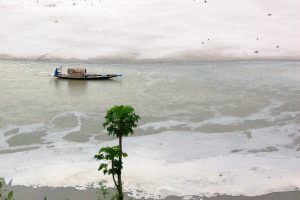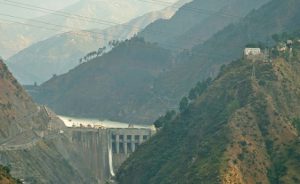In his first trip abroad since becoming China’s premier Li Keqiang promised to share more data on transboundary rivers with India. But Manmohan Singh, India’s prime minister, wanted more, including information on China’s plans on the biggest river the two countries share – the Brahmaputra, known as Yarlung Zangbo in China.
In concrete terms, the two sides agreed in New Delhi on May 20 to extend their agreement by which China shares some hydrological data during the monsoon months and warns India every time there is a flood threat along any of their shared rivers. Such a warning saved inhabitants of two villages in 2008, while the absence of it killed over 100 Indians in 2000.
After meeting Li in the presence of a few aides on May 19 and then holding full delegation level talks on May 20, Singh said, “I also reiterated to Premier Li India’s concerns about the effects on lower riparians of activities in the upper reaches of our shared rivers. It would be useful for the mandate of our Expert Level Mechanism to be expanded to include information sharing on upstream development projects on these rivers. I am glad that we have agreed to expand cooperation on trans-border rivers. It would also be useful for India and China to collaborate on a better understanding of the stresses on our shared Himalayan ecosystem.”
Singh was referring to the three hydropower projects being built on the river in Tibet. China has said repeatedly that all three are run-of-the-river projects which will not impound any water, but photographs taken by Indian satellites are inconclusive, at least for one of the projects.
Addressing the media along with Singh in New Delhi’s historic Hyderabad House, Li said, “With regard to Indian concerns on rivers, we have shared information on trans-border rivers. We are ready to step up communication on water resources and environmental protection.” He did not elaborate, nor did the two premiers take questions from the media.
In their very first meeting on May 19, Singh had pushed the transboundary rivers issue, asking Li to ensure that the Chinese government share more than hydrological data. India is keen to get full information on Chinese plans on the Brahmaputra, because that impacts India’s plans on the river. “Trans-border rivers should unite, not divide us,” Singh told Li.
As Li admitted candidly, there are other thorny issues between the world’s two most populous nations – a disputed border that goes right across the Himalayas, and India’s growing trade deficit with China. The Chinese team reached New Delhi eager to ink agreements that will further open up the huge Indian market to Chinese goods. China is willing to provide concessions to Indian exporters in return, but Singh made it clear to Li that substantive trade agreements would depend on advances over shared rivers and the border.
The border dispute between China and India has flared up most recently, with each side blaming the other of setting up military posts within the no man’s land in Ladakh, at the western end of the Tibetan plateau. A tense three-week standoff has just been sorted out with difficulty, and Indian observers were angry because Singh described it as an “incident” rather than an “incursion” by Chinese soldiers.
The Indian prime minister’s choice of words was designed to defuse tension, and Li responded by saying that the border dispute was a “legacy of history” that would have to be sorted out through negotiations. Meanwhile, he said, “the two countries have worked to maintain tranquillity and peace in the border areas.” Li pushed for much more trans-border trade than happens now. Both sides recognise that to be one of the best ways to reduce tension.
The river issue is more complex, as both governments want to maximise the number of hydropower projects in the huge Brahmaputra basin that drains much of the eastern Himalayas. India has been very concerned that China will build more and more projects – including dams – on its stretch of the Brahmaputra and thus reduce the water available for hydropower in India. New Delhi has repeatedly sought more information from Beijing on its plans, but to no avail. It is not at all certain that the situation will improve after the May 20 summit.
As for the Expert Level Mechanism Singh talked about, a team of Indian hydrologists was in Beijing for days to prepare for Li’s visit, in the hope that a substantive agreement on sharing transboundary river waters could be signed during the summit. But it was made clear to them that such an agreement was not on the cards, as far as the Chinese government was concerned.
Reports from Beijing said the Chinese authorities were determined not discuss any major agreement on any river that originated in Tibet, because they were afraid it may impact the flow of water to the Yellow and Yangtze rivers, the two major rivers of China. Apart from India, seven countries are downstream of rivers that originate in Tibet, and Beijing has refused to have substantive agreements with any of them.
India is not asking for a substantive agreement on the Brahmaputra or any of the shared rivers, as New Delhi understands the futility of such a move. It is seeking more information than China has agreed to provide so far. Li did not make any new promise in this regard during the summit.
Neither side has had any substantive talks yet on the issue with Bangladesh, the lowermost riparian country. Nor have they discussed their plans with independent experts and the civil society. Twenty-six voluntary organisations in north-eastern India – where the Brahmaputra flows down from China – wrote a joint letter to Singh, Li and Bangladesh premier Sheikh Hasina on May 20, protesting the situation.
India and China did sign other important agreements on May 20 to safeguard the ecology of the Himalayas – the water tower that is crucial to both countries. The two countries will work together to preserve the ecology of the Kailash-Mansarovar area in Tibet – the headwaters of the Brahmaputra, the Indus and one of the major tributaries of the Ganga, apart from being one of the holiest pilgrimage spots for Hindus and Buddhists alike.



